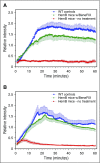Prophylactic efficacy of BeneFIX vs Alprolix in hemophilia B mice
- PMID: 27106122
- PMCID: PMC5291301
- DOI: 10.1182/blood-2016-01-696104
Prophylactic efficacy of BeneFIX vs Alprolix in hemophilia B mice
Abstract
FIX binds tightly to collagen IV. Furthermore, a FIX mutant, FIXK5R, which binds better than wild-type FIX to collagen IV, provides better hemostasis than wild-type FIX, long after both are undetectable in the plasma. There is also credible evidence of extravascular FIX. Here, we use the saphenous vein bleeding model to compare the efficacy of recombinant FIXFc (Alprolix) and wild-type FIX (BeneFIX) in hemophilia B mice 7 days postinfusion. Although the terminal half-life of Alprolix is significantly longer than that of BeneFIX, at equal doses Alprolix is not better at controlling bleeding 7 days postinfusion, presumably because of the extravascular FIX. Both BeneFIX and Alprolix exhibit a linear response in clotting efficacy up to 150 IU/kg, where they appear to saturate an extravascular compartment, because there is no additional prophylactic benefit from higher doses. A robust pool of extravascular FIX is clearly observed surrounding blood vessels, localized to the same region as collagen IV, in 2 representative human tissues: liver and skeletal muscle. We see no increased risk for thrombosis at 250 IU/kg FIX at 6 hours postinfusion. In summary, 7 days postinfusion into hemophilia B mice, BeneFIX and Alprolix are hemostatically indistinguishable despite the latter's increased half-life. We predict that doses of FIX ∼3 times higher than the currently recommended 40 to 50 IU/kg will, because of FIX's large extravascular compartment, efficiently prolong prophylactic hemostasis without thrombotic risk.
© 2016 by The American Society of Hematology.
Figures




Comment in
-
Fill 'er up? Fill what up?Blood. 2016 Jul 14;128(2):156-7. doi: 10.1182/blood-2016-05-713040. Blood. 2016. PMID: 27418627 No abstract available.
References
-
- Srivastava A, Brewer AK, Mauser-Bunschoten EP, et al. Treatment Guidelines Working Group on Behalf of The World Federation Of Hemophilia. Guidelines for the management of hemophilia. Haemophilia. 2013;19(1):e1–e47. - PubMed
-
- Björkman S. Pharmacokinetics of plasma-derived and recombinant factor IX - implications for prophylaxis and on-demand therapy. Haemophilia. 2013;19(6):808–813. - PubMed
-
- Soucie M, Monahan P, Mazepa M, Kulkarni RP, Konkle BA. Hemophilia Treatment Center Network. Relations between factor activity level and joint bleeding in a large cohort of males with mild and moderate hemophilia in the United States [abstract]. J Thromb Haemost. 2015;13(Suppl 2) Abstract 157.
-
- Powell JS, Pasi KJ, Ragni MV, et al. B-LONG Investigators. Phase 3 study of recombinant factor IX Fc fusion protein in hemophilia B. N Engl J Med. 2013;369(24):2313–2323. - PubMed
Publication types
MeSH terms
Substances
Grants and funding
LinkOut - more resources
Full Text Sources
Other Literature Sources
Medical
Molecular Biology Databases

